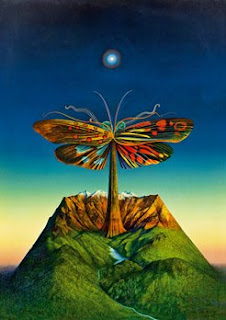
Her series of Goddesses were singular for defining the cultural subtext of each Goddess by using textile scraps that reflected each area of the world from which each Goddess came.
That said, for the past ten or fifteen years, Zerner and her husband Monte appear to have concentrated primarily on turning the images of her textile works into twee advice books, tarot card sets and pre-packaged divination systems and peddling them as hard as they can. I find their website with its self-congratulatory, new agey tone and photos taken with celebrities to be somewhat crass...cheesy...undignified. That's how I see it. I ran across their site and was astounded to find how the artwork I have come to love felt so marketed. The deep and resonant tone of the work doesn't align with the promotion of it.
However, I believe Amy Zerner works in an enchanted way with her materials. The following is a description of how she begins a textile piece, and it describes very well the instinctive, poetically resonant state of receptive meditation that one enters when beginning to work. Amy Zerner's enchanted process, from Monte Zerner:
"She begins her complex accretions of fabric with trust in the fragment. She goes to her little trunks or bags or boxes, haphazardly pulling out this little clump of remnants, that wisp of lace, those shreds of metallics and threads. She is performing a ritual act, an incantation, a ceremony that was decided a long time ago, for which she is the medium.
She scatters her pieces in heaps in a ring on the floor. She sits down in the center of it all and waits for the first impulse. The first move will set free the many others that follow. Suddenly she rises and goes like a sleepwalker straight to one of her piles of textile fragments. She picks a piece of iridescent netting, takes up her scissors, and cuts a shape. She has already prepared her "canvas", the rectangular fabric backing with the outer border already sewn in as a frame. She places the first fragment in the middle of the lower portion of the backing.
She does not know what she is going to do next, which of the hundreds of fragments or rags she will turn to, separating it from its own little heap of related pieces (not similar scraps, but pieces related through source or time or some other association). It is all decided intuitively, on the spot, layer on layer, as she goes along. She is not aware of any conscious thinking as she moves from one piece of cloth to the next. She is totally in her own world, at one with her obsession, unaware of anything else going on around her.

She spreads each fragment on the backing, putting this one on that one, this next to that, silently for hours. Gradually, miraculously, images begin to emerge. They are as surprising to Amy as to those watching her work. Generally, she is entirely alone during the process of composition, sitting and rising from the floor, pausing, bending to place this patch and that piece, turning and reaching in the midst of her multitude of bags and boxes.
She moves constantly, unaware of anything else around her, gradually building detail. Many of these fragments are old, precious, and costly. She will risk them for the spiritual treasure she pursues. She has no preparatory sketches. She simply recognizes what happens as it is happening, without really knowing how it happened. It is amazing, even to the artist.
Each work emerges the way Robert Frost, in a letter to Louis Untermeyer, described the emergence of a poem: "A poem is never a put-up job, so to speak. It begins with a lump in the throat, a sense of wrong, a homesickness. It is never a thought to begin with. It finds its thought and succeeds, or doesn't find it, comes to nothing. It finds its thought and the thought finds the words."





















 And, Norval Morrisseau was not a shamanic artist. He did not purposefully work with his manito to create his paintings, although he hinted that he did. He never mentioned a specific Spirit helper, he did not articulate how his work could heal people. He made beautiful art, and maybe his ancestral spirits did work through him and onto the canvas.
And, Norval Morrisseau was not a shamanic artist. He did not purposefully work with his manito to create his paintings, although he hinted that he did. He never mentioned a specific Spirit helper, he did not articulate how his work could heal people. He made beautiful art, and maybe his ancestral spirits did work through him and onto the canvas. 







